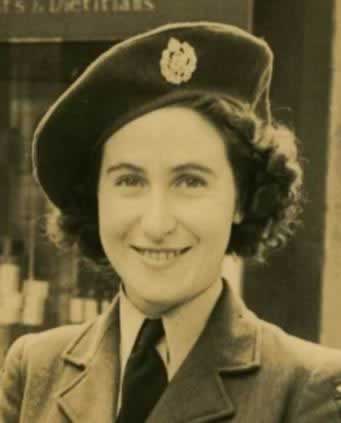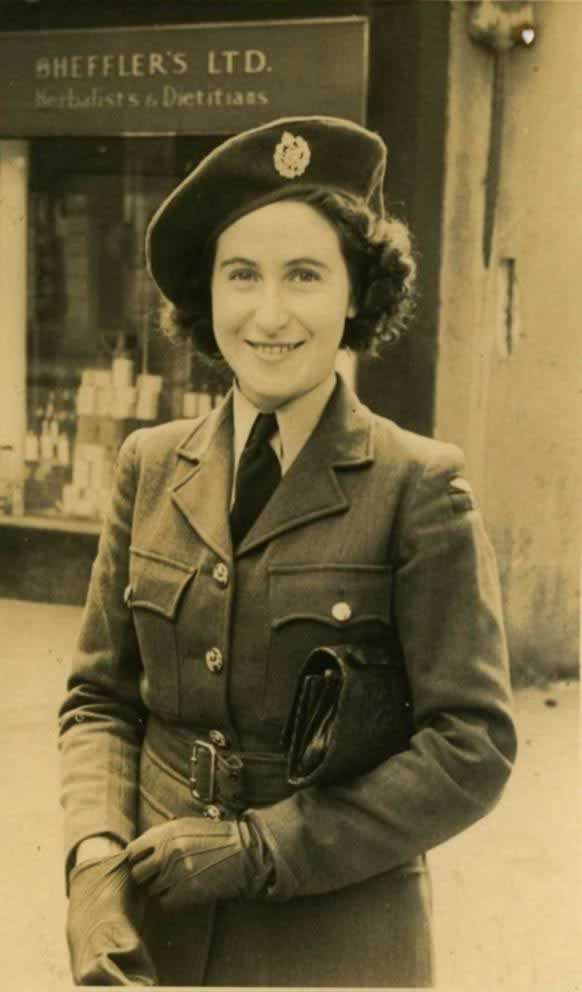
_
______________________
Melva Olive SAYER
Formerly Melva Browne, then Melva Anderson
Serial Number: W5206
RNZAF Trade: Radar Operator
Date of Enlistment: 17th of April 1943
Date of Demob: 8th of September 1945
Rank Achieved: Acting Corporal, then reduced back to WAL
Flying Hours: nil
Operational Sorties: nilDate of Birth: Born on the 5th of August 1919, at Upper Hutt
Personal Details: Melva Browne grew up in the Wellington district, and was educated at Kaitoki School ("There were six of us at the school and half of us were Brownes" she says.) Her secondary education was done at Lower Hutt High School.Melva was married to Second Lieutenant Roger Kingston Anderson (2738, 26th Battalion), three weeks into the war. He went overseas and was heavily involved with fighting in the North African desert campaign. He was killed in battle on the 28th of November 1941, aged 28.
Melva had trained as a short-hand typist and was quite proficient at this when her bosses at National Electrical, where she worked, discovered she also had a head for figures and her career took her along that path.
Service Details: In 1943 Melva decided to join the Air Force. There was quite a reason behind this. After a year of being a grieving widow she had begun to go out again and have fun. She went out with one or two soldiers, who she says in turn went overseas and were killed. Then the Americans arrived in Wellington and that was the catalyst for her leaving for the WAAF. "I wanted to get away from the Yanks," she says. She didn't like their attitude towards women, and especially war widows. She says, "They knew they were going to die, so they were after a good time. I was having none of it."
She applied and was interviewed on the 16th of April 1943 at Air Department in Wellington specifically for the role of Radar Operator. The interview involved several tests and she feels that the clincher that got her in was the fact that she could add up a long column of figures quickly and got the sum correct. None of the other girls got it right. Another test she underwent was they gave her a six-figure number to memorize, and then she had to walk out the door, turn right, then left, then lift a telephone receiver and state the number. The whole time the instructors were talking deliberately behind her in an attempt to make her forget the number. She recalls, "What they didn't know was that often I had to relieve for the telephone operator at National Electrical, and in that job you had to remember a lot. So I was prepared well for this simple task."
Melva passed the tests and was taken on in the role of Radar Operator. Her Radar training was at RNZAF Station Levin, where she turned up in civilian clothes on the 17th of April 1943, the very day after she'd taken the test, and was thrown straight into training upon arriving.
She was in the very first intake of WAAF Radar Operators, and she found that all the other girls on the course were already in the WAAF and had been for some time. They had been selected from other jobs on other bases and were the cream of the intelligentsia of the WAAF.
This posed something of a problem because all the other girls had been trained in the ways of the Air Force, but Melva was not. They got stuck straight into Radar training, and Melva was never taught the basics of RNZAF life such as marching or discipline, etc. To make matters worse they didn't even give her a uniform, and she completed the course in her civvie clothes.
Melva was trained in reading the Radar screens and plotting aircraft, etc. One big part of the training was using your memory. She recalls that they were never allowed to use pencils or paper, everything had to be committed to memory, and recalled precisely when needed. After two or three days, she recalls, the instructors began to weed out the girls who could not cope with the memory tests.
The course lasted till the 26th of June 1943, and once fully trained Melva was posted to No. 60 (Radar) Squadron. Within this unit Melva got to move around a little bit.
Each Radar facility was top secret, so when they moved to and from one of these stations, the workers had to go in the back of covered wagons. This was so as not to arouse suspicion from locals, but as Melva says, the locals must have been aware of such stations inn their back yards as they'd have seen them being built.
The first station Melva went to was situated on a headland just above Hot Water Beach at Whitianga. A tour of duty on these stations was up to three months, and once they set foot on the station the Radar Operators were not allowed off at all for three months. No contact with any locals was allowed either. After the three month stint on a station, the Radar Operators were then allowed a week's leave, before moving onto the next station.
On each station Melva recalls there were usually 10 girls and maybe 20 men. They worked the Radars constantly for 24 hours per day, and each operator worked an eight hour shift that rotated from week to week so that they would do a day shift one week, a night shift the next and the early morning shift the week after.
Melva recalls her first job upon getting to the station at Hot Water Beach was scaling a Radar mast that was about three times the height of an average street power-pole. From the top, where she had to check equipment, she looked down and saw some whales ambling past in the sea below. She says that is all she saw from that station.
Melva's next unit was at Piha, west of Auckland. Here she was made a WAAF Supervisor. She doesn't know why she was chosen to be a supervisor over other girls. "I didn't have a clue, not a clue," she said, about the job she was doing. By this stage she still hadn't received a proper uniform and was wearing only WAAF Fatigues. Because she moved round the country secretly, the uniform that had been ordered for her could not be forwarded on, so took more than six months to catch up with her.
Following a time at Piha, Melva's squadron then moved to a Radar station that was about halfway long Ninety Mile Beach. On the way they had stopped for a meal at RNZAF Station Waipapakauri, and this was the only contact they had with the outside world before going onto the station. This station was actually non-operational, and she soon moved to another Radar facility at Helensville, above Auckland. This was to be her final posting to a Radar station.
Also while at Helensville she recalls the Radar picking up a suspicious contact, which was a very rare occurrence. She recalls an aircraft was seen and tracked by their's and other stations, which was heading in from the Tasman Sea direction towards the east, and it had no IFF, or Identification Friend or Foe. The IFF was a device aboard Allied aircraft that sent a signal to ground Radar units indicating they were Allied and friendly. This aircraft was tracked flying across the northern-most tip of the North Island, and then disappearing again off radar once it had gotten to the east of the coast. She says they never found out exactly what it was, and one theory was it was an Allied, perhaps American, aircraft that had been damaged and was lost. Another theory was more sinister, perhaps it was a Japanese floatplane. When one considers the story that another Cambridge resident, Ernie Gorringe, has told, about a japanese floatplane that washed up at Waipapakauri in 1943, this may have been the same aircraft.
On the 5th of January 1944 Melva was posted to RNZAF Station Whenuapai (probably for a period of leave), and a week later on the 12th she was transferred to Air Department in Wellington. There she reverted to her prewar skills as a typist and office worker. After two weeks with Air Department, Melva moved onto Air Training Corps Headquarters, also in Wellington, on the 1st of February 1944. Here she describes her job as a "clerical roustabout."
Melva remained at ATC HQ as a clerical worker till the 30th of May 1945, when she returned to Air Department doing the same work. She then finished the last few days of her WAAF career with a unit that her papers describe as NEP Central Cat. 8, which she does not recall at all. This was no doubt to do with her discharge, which came on the 8th of September 1945.
During her Air Force career, Melva says she was unlike other girls in the WAAF in that she didn't care less about rank and trying to climb the ladder. She says she was very surprised that for a time she was made a WAAF supervisor with the temporary rank of Acting Corporal, and it seemed odd to her that she was made so when she didn't even have a uniform. The uniform did eventually catch up with her, after she'd finished as a Radar Operator. The accompanying photo was taken in Auckland before she went back south to Air Department.
Because she had never been given the proper initiation into the Air Force, in the form of a Basic Training course, Melva says she never really treated her job like being part of the military as others did. It was just a job.
After the war in 1946 Melva married Charlie Sayer, whom she'd met on a train between Timaru and Christchurch after he'd just returned from serving in the Middle East with the army. They moved to Cambridge in 1948.
Died: Melva died on the 22nd of October 2011
Connection with Cambridge: Melva moved to Cambridge from Otorohanga in 1948 with her husband, and they became jewellers in Cambridge
Note: To find out much more about the important secret work done by RNZAF and WAAF Radar Operators, I recommend that you track down the book "Radar Stories of the RNZAF" by Ian Sexton. I believe there was also a second volume by the same compiler. These books were compiled after a 50th Anniversary Reunion, where former Radar Operators were asked to all write down their memories and stories. The books were produced as a limited run on a semi-amateur basis but are available in good New Zealand libraries so can no doubt be inter-loaned.
Above: Melva finally got her uniform. This photo was taken in Auckland in early 1944
________________________________________________________________
| Home | Airmen | Roll of Honour |
|---|

